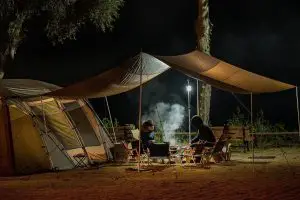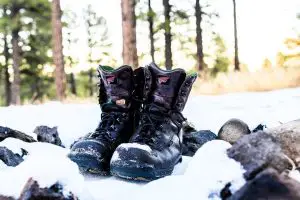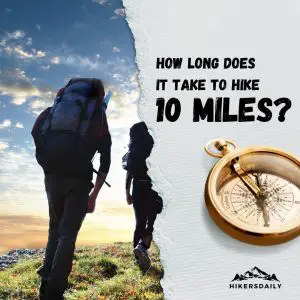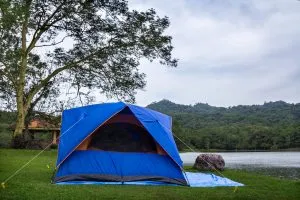What Are Walk-Up Only Campsites? All You Need to Know
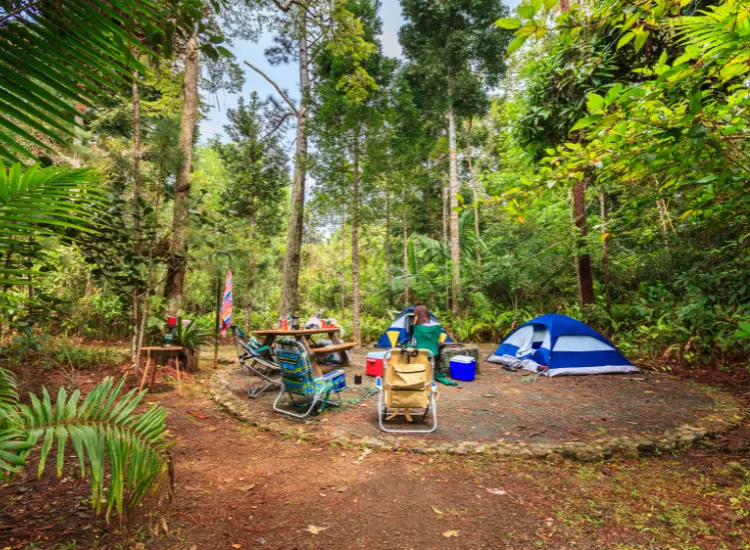
What are walk-up only campsites? If you’re an adventurous traveler (like me) who loves camping, this is a question you might be asking. Walk-up only campsites are a type of camping option where reservations are not accepted in advance, and sites are allocated on a first-come, first-served basis. They provide a unique camping experience that requires spontaneity and flexibility.
Imagine embarking on a camping trip without knowing exactly where you’ll be pitching your tent that night. With walk-up only campsites, you have the opportunity to explore different campgrounds and choose the perfect spot as you go along. This type of camping appeals to those who enjoy a sense of adventure and embrace the unpredictability of the outdoors. Let’s explore a bit further!
Quick Links
Advantages of Walk-Up Only Campsites
Flexibility and Spontaneity
One of the main advantages of walk-up only campsites is the flexibility and spontaneity they offer. Unlike campsites that require reservations, walk-up only campsites allow campers to decide on their camping trip on the spot. This is especially convenient for those who prefer to have the freedom to choose their camping destination without the need for advanced planning.
Availability
Walk-up only campsites often have a higher availability compared to campsites that require reservations. Since these campsites operate on a first-come, first-served basis, there is a greater chance of finding a spot even during peak camping seasons. This is beneficial for campers who may not be able to secure a reservation in advance or for those who prefer more spontaneous camping experiences.
No Booking Fees
Another advantage of walk-up only campsites is the absence of booking fees. Unlike campsites that require reservations, walk-up only campsites do not charge any fees for booking in advance. This can lead to cost savings for campers and make camping more accessible to a wider range of individuals and families.
Closer to Nature
Walk-up only campsites are often located in more remote or lesser-known areas, allowing campers to get closer to nature. These campsites may offer a more secluded and peaceful camping experience, away from the crowds that may be found at popular campsites. Campers can enjoy the tranquility of the natural surroundings and have a greater chance of spotting wildlife or exploring less-traveled trails.
Potential for Last-Minute Availability
For campers who may have last-minute changes in their plans or for those who prefer to be spontaneous, walk-up only campsites offer the potential for availability even without a reservation. This means that campers can decide to go camping on short notice and still have a chance to secure a campsite. It provides flexibility for those who may have unpredictable schedules or prefer to make spontaneous trips into the great outdoors.
How to Secure a Walk-Up Only Campsite
Securing a walk-up only campsite can be a bit challenging but with the right approach and preparation, it’s definitely doable. Here are some tips to help you secure a walk-up only campsite:
- Arrive early: Get to the campsite as early as possible, preferably before the check-in time. This will increase your chances of getting a spot.
- Weekday vs. weekend: If your schedule allows, consider camping on weekdays instead of weekends. Campgrounds tend to be less crowded during weekdays.
- Be flexible with dates: If you have the flexibility, try to plan your camping trip during non-peak seasons or less popular dates. This will increase your chances of finding available walk-up campsites.
- Campground research: Do thorough research on the campgrounds you’re interested in. Check their availability, busy times, and any reservation policies or restrictions they may have.
- Have a backup plan: In case your desired campsite is already full, have a backup plan in mind. Research nearby campgrounds or consider dispersed camping options in the area.
- Be prepared to split up: If you’re camping with a large group, be prepared to split up into smaller groups if necessary. This increases your chances of finding neighboring walk-up campsites.
- Ask the campground host: When you arrive at the campground, talk to the campground host or staff. They may have information on recently vacated sites or cancellations that haven’t been updated online.
- Be patient: Securing a walk-up campsite may require patience and persistence. Stay positive and be open to exploring alternative camping options if needed.
By following these tips and approaching the process strategically, you can increase your chances of securing a walk-up only campsite for an enjoyable camping experience.
Availability of Walk-Up Only Campsites
Walk-up only campsites offer a unique camping experience for outdoor enthusiasts. Unlike traditional campsites that can be reserved in advance, walk-up only campsites are available on a first-come, first-served basis. These campsites provide a spontaneous and adventurous camping option for those who enjoy flexibility and embrace the thrill of uncertainty. Here are some important factors to consider when it comes to the availability of walk-up only campsites:
Seasonal Availability and Popular Times
The availability of walk-up campsites can vary depending on the season and location. During peak camping months, such as summer weekends or holidays, walk-up campsites tend to fill up quickly. It’s important to arrive early in the day to secure a spot, especially at popular camping destinations. Planning camping trips during less crowded times or weekdays can increase the chances of finding an available walk-up campsite.
Arrival Time and Strategies
Arriving early is key when it comes to securing a walk-up campsite. Many campgrounds have strict arrival times, and camping permits may only be issued during specific hours. Researching the campground’s check-in times and policies beforehand can help campers plan their arrival accordingly. Additionally, having a backup plan or alternative campgrounds in mind can be advantageous in case all walk-up sites are occupied.
Length of Stay and Campsite Turnover
Walk-up only campsites generally have a limited length of stay, typically ranging from one to a few nights. This allows for campsite turnover and gives other campers a chance to enjoy the camping experience. It’s important to be mindful of the established rules and regulations regarding length of stay to ensure a fair and enjoyable camping environment for all visitors.
Alternative Accommodations and Flexibility
In the event that all walk-up campsites are occupied, having alternative accommodation options or backup plans can be beneficial. Nearby campgrounds that accept reservations, dispersed camping areas, or even nearby hotels or cabins can provide alternative options if walk-up campsites are unavailable. Maintaining an open and adaptable mindset allows campers to make the most of their camping adventures, even if their initial plans don’t go as expected.
Overall, walk-up only campsites offer an exciting and spontaneous camping experience for outdoor enthusiasts. With proper planning, flexibility, and an understanding of the availability factors, campers can enjoy the thrill of securing a walk-up campsite and embrace the adventure of a spontaneous camping trip in nature.
Preparing for a Walk-Up Only Campsite
Walk-up only campsites can offer a unique camping experience, but they require a bit more planning and preparation, as mentioned, compared to camping at a reserved campsite. Here are some tips to help you prepare for a walk-up only campsite:
- Arrive early: As mentioned previously, walk-up campsites are available on a first-come, first-served basis, so it’s important to arrive early in the day to increase your chances of securing a spot.
- Check availability: Before heading to the campsite, check if there are any restrictions or closures in place that may affect availability. Some popular campsites may fill up quickly, especially during peak camping seasons.
- Come prepared: Since walk-up campsites don’t have reservations, be sure to bring all the necessary camping gear with you, including tents, sleeping bags, cooking equipment, and food.
- Be flexible: Keep in mind that walk-up campsites may have limited availability or specific restrictions. Be open to adjusting your camping plans or exploring alternative campsites if needed.
- Plan for backup options: If your desired walk-up campsite is full, have a backup plan in mind. Research nearby campsites or consider dispersed camping options in the area.
- Check local regulations: Familiarize yourself with any specific rules or regulations for the walk-up campsite and follow them accordingly to ensure a safe and enjoyable camping experience.
- Be respectful: Practice good camping etiquette by keeping noise levels to a minimum, cleaning up after yourself, and respecting the natural environment and other campers.
By following these tips and being prepared, you can make the most out of your walk-up only campsite adventure and enjoy the beauty of nature in a more spontaneous camping setting.
Permit Requirements for Walk-Up Only Campsites
Understanding Walk-Up Only Campsites
Walk-up only campsites are camping areas where reservations cannot be made in advance. Instead, campers must arrive at the campground and secure a campsite on a first-come, first-served basis. These campsites are often popular among spontaneous campers or those who prefer a more flexible camping experience.
Permit Process for Walk-Up Only Campsites
When planning to camp at a walk-up only campground, it is essential to understand the permit requirements and procedures. Typically, campers will need to check in at the campground office or self-registration station upon arrival. They may need to fill out a registration form, provide identification, and pay any applicable fees for the campsite.
Availability and Occupancy Limits
Walk-up only campsites operate on a first-come, first-served basis, meaning that availability can vary depending on the popularity of the campground and the time of year. It is advisable to arrive early to secure a campsite, especially during peak camping seasons. Some walk-up only campsites may have occupancy limits, so it’s important to inquire about any restrictions or guidelines in place.
Additional Considerations
Before embarking on a walk-up only camping trip, it is recommended to research the specific campground’s rules and regulations. Some campgrounds may have specific requirements or restrictions, such as maximum stay limits or designated campfire areas. Being aware of these considerations beforehand can help ensure a smooth and enjoyable camping experience.
Tips for Finding Walk-Up Only Campsites
Finding walk-up only campsites can add spontaneity and adventure to your camping trips. These campsites typically operate on a first-come, first-served basis, allowing campers to secure a spot without advance reservations. Here are some tips to help you find walk-up only campsites:
- Research Campground Options: Look for campgrounds that offer walk-up only sites. National forests and certain state parks often have designated walk-up areas.
- Check Availability and Seasons: Some campgrounds have walk-up sites available year-round, while others may only offer them during specific seasons. Make sure to check the availability of walk-up sites before your trip.
- Arrive Early: To increase your chances of securing a walk-up site, arrive early in the day. Popular campgrounds can fill up quickly, especially during weekends and peak camping seasons.
- Be Flexible: Keep an open mind and be willing to explore different campgrounds or areas if your desired walk-up site is already occupied. Having a backup plan can make your camping experience smoother.
- Weekday Camping: Consider planning your camping trip during weekdays instead of weekends. Campgrounds tend to be less crowded, making it easier to find available walk-up sites.
- Be Prepared: Pack essential camping gear, such as a tent, sleeping bags, cooking equipment, and camping essentials. Bringing everything you need will allow you to set up camp quickly once you secure a walk-up site.
- Know Campground Policies: Familiarize yourself with the campground’s rules and policies. Some walk-up sites may have specific limitations or restrictions, such as maximum stay durations.
- Ask Park Rangers or Campground Hosts: Seek information from park rangers or campground hosts. They can provide valuable insights and tips on finding available walk-up sites or alternative camping options in the area.
By following these tips, you can increase your chances of finding and securing a walk-up only campsite for your outdoor adventures. Remember to plan ahead, stay flexible, and enjoy the thrill of discovering new camping spots along the way.
Facilities and Amenities at Walk-Up Only Campsites
Walk-up only campsites offer a unique camping experience for outdoor enthusiasts. These campsites typically do not require advance reservations and operate on a first-come, first-served basis. While the lack of advanced booking may seem daunting to some, walk-up only campsites often provide a range of facilities and amenities to ensure a comfortable and enjoyable stay. Here are some common facilities and amenities you can expect at walk-up only campsites:
Campsite Pads or Tent Sites
Walk-up only campsites usually offer designated campsite pads or areas for setting up tents. These areas are often equipped with level ground and designated spaces for tents or RVs, allowing campers to easily set up and secure their shelter for the night.
Fire Rings or Campfire Areas
Many walk-up only campsites provide fire rings or designated campfire areas. These allow campers to safely build and enjoy a campfire during their stay. Campfires provide warmth, a place to cook food, and a cozy ambiance for gathering around during the evening hours.
Picnic Tables and Seating Areas
To enhance the camping experience, walk-up only campsites often have picnic tables and seating areas. These outdoor amenities provide a convenient space for campers to enjoy meals, play games, or simply relax and take in the surroundings.
Vault Toilets or Restroom Facilities
Walk-up only campsites typically have restroom facilities to ensure basic sanitation needs are met. These may include vault toilets or more traditional restroom facilities, depending on the location and amenities provided. Having access to clean and functional restrooms is important for camper comfort and convenience.
Water Access Points
Many walk-up only campsites offer water access points or provide access to nearby water sources, such as lakes, rivers, or streams. These access points allow campers to refill water containers, wash dishes, or enjoy recreational activities like swimming, fishing, or boating.
Nature Trails and Hiking Paths
Walk-up only campsites often provide access to nature trails or hiking paths. These trails allow campers to explore the natural surroundings, enjoy scenic views, and engage in outdoor activities like hiking or bird-watching. Having access to nearby trails enhances the overall camping experience and allows campers to connect with nature.
While the specific facilities and amenities may vary from one walk-up only campsite to another, these are some common offerings that provide convenience, comfort, and opportunities for outdoor recreation. When planning a camping trip to a walk-up only campsite, it’s always a good idea to research and check the available facilities and amenities beforehand to ensure a successful and enjoyable camping experience.
Alternatives to Walk-Up Only Campsites
Walk-up only campsites can provide a sense of adventure and spontaneity, but they may not always be the most convenient option for every camper. If you prefer a more predictable camping experience or want to ensure availability during peak seasons, there are several alternatives to consider. Here are some options to explore:
- Reservation-based campsites: Many campgrounds offer the convenience of making reservations in advance. This allows you to secure a campsite and plan your trip accordingly without the uncertainty of walk-up availability.
- Online booking platforms: Utilize online platforms and websites dedicated to camping reservations. These platforms often provide a wide range of campsite options, allowing you to choose specific dates and locations that suit your preferences.
- State and national park campsites: State and national parks often have reservation systems in place, allowing you to book campsites ahead of time. Research the parks in your desired location and check their respective websites for availability and booking information.
- Private campgrounds: Explore private campgrounds that offer reservation services. These campgrounds may have additional amenities and facilities, providing a more structured camping experience.
- Alternative accommodations: If campsites are fully booked or you prefer a different type of lodging, consider alternatives such as cabins, RV parks, or glamping sites. These options often require reservations and provide a comfortable camping experience.
While walk-up only campsites can be exciting for spontaneous campers, it’s always good to have backup options and explore alternatives that offer more certainty and convenience. By planning ahead and utilizing reservation systems, you can enhance your camping experience and avoid potential disappointment due to limited availability.
Conclusion
Walk-up only campsites offer the opportunity for flexibility and spontaneity with camping trips. With a first-come, first-served system, campers can decide on their camping destination on the spot and have a higher chance of finding available campsites, even during peak seasons. These campsites often provide essential facilities such as campsite pads, fire rings, picnic tables, restroom facilities, and access to water sources. They also offer a closer connection to nature, with the possibility of exploring nearby nature trails and hiking paths.
If walk-up only campsites are not your preferred camping option, there are alternatives to consider, such as reservation-based campsites, online booking platforms, state and national park campsites, private campgrounds, or alternative accommodations like cabins or RV parks.
Ultimately, whether you choose a walk-up only campsite or go for a different camping experience, the goal is to embrace the beauty of nature and create lasting memories in the great outdoors.

